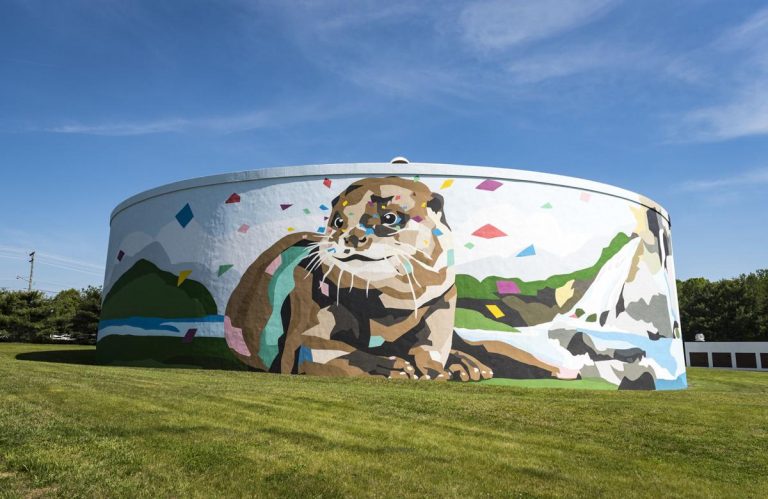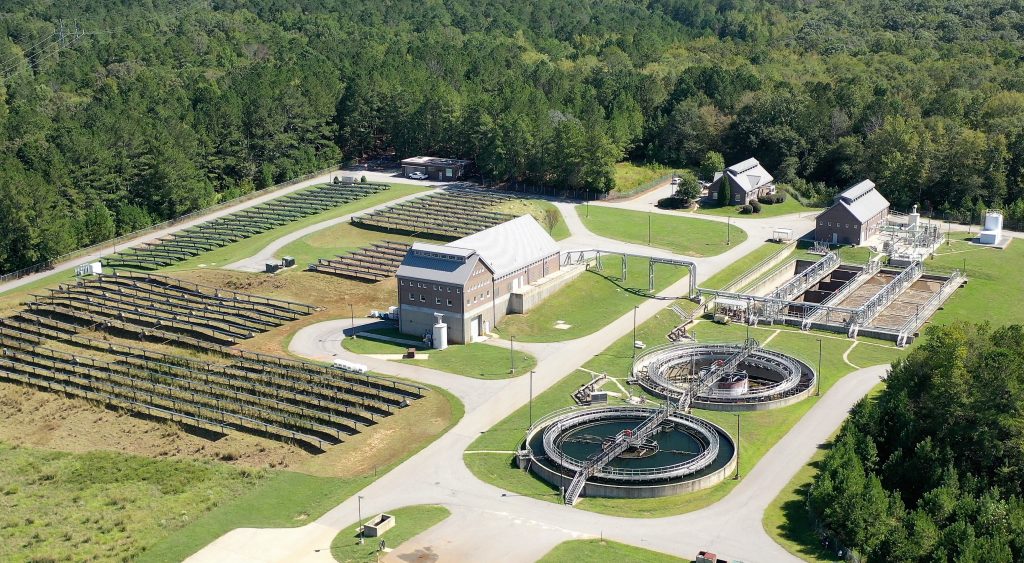
It’s time to vote in the #ELGLKnope National Championship! Read about this matchup, and then submit your vote! One vote per email address, please. Voting closes at 11:00p.m. PT on Sunday, April 4. We’ll tally the votes and will post the winner on Monday, April 5!
Vote! Vote! Vote!

Sides Road Water Tank
Winston Salem, North Carolina 27106
- Three words to describe Sides Road Water Tank: Artistic, Collaborative, Educational
- Why are you nominating Sides Road Water Tank: The Sides Road Water Tank hosts a mural is named “A Morning on the Yadkin River.” The mural, painted/designed by Florida based artist known as Daas, depicts an American River Otter. Otters are native to the Yadkin River which serves as the main source of water for the region. The mural was created through a public/private partnership with the Lidl grocery chain, the Winston-Salem/Forsyth County Utilities, and the Winston-Salem Public Art Commission. It is visible to approximately 25,000 drivers every day, bringing attention to our water resources and what they mean to our city. Finally, the water tank is being nominated because it’s absolutely adorable – not a fact, but a very, very strong opinion.
- Anything else to share? This links to a really fun time-lapse video of the otter being painted.

Cedar Creek Water Reclamation Facility
Athens, Georgia 30605
- Three words to describe Cedar Creek Water Reclamation Facility: Indispensable, Poopular, Sparkling
- Why are you nominating Cedar Creek Water Reclamation Facility: I write to nominate the Cedar Creek Water Reclamation Facility in Athens, GA. I hope my story below explains why I believe this location is worthy of competing for the #ELGLKnope Award.The threatening weather could have played perfectly into the scheduled Halloween-themed Trick or Treatment event. However, we decided the drizzling, wet, and foggy conditions were not ideal for a Cedar Creek Water Reclamation Facility (WRF) tour. We sent word of the last-minute cancellation along with our regrets to the registered tour participants.As I approached the facility gate to head home, I saw a waiting car. Perhaps someone who hadn’t received the news of the cancellation? I rolled down my window to find a young knight, Spiderman, and their parents in the other vehicle. They had not gotten the message about our need to postpone.Per the Halloween tour instructions, the boys had dressed in costume, ready for their visit. The parents’ eyes pleaded with me as they explained how their oldest son was always asking what happens to the water after he flushes the toilet. They had promised to show him the path of his poop. As if on cue, the rain stopped. Not wanting to be one who disappoints, I offered to go ahead with the tour so these curious boys could solve the mystery of the flush.I introduced the family to Cedar Creek WRF, the smallest of three such facilities in Athens, GA. Cedar Creek WRF rests on 40 acres nestled within a larger 500-acre wooded area. We recently installed a solar array on an open grassy field to offset energy costs and meet the local government’s ambitious green energy goals. I shared with my guests that we often hire sheep – yes, the wooly kind – to come in and mow beneath the solar panels. Lawnmowers can throw rocks and break the panel glass; goats chew the necessary wires and tend to jump on top of the array. Sheep are who “ewe” want for the job.We followed along the treatment train that almost 2 million gallons of collected water flow every day. At the band screens, a ghost floated nearby. This particular apparition was a “ghost” made of past flushable wipes, a tour decoration still waiting to haunt. The knight and Spiderman stopped for a photo while learning about the importance of the 4 Ps of Flushing: Only Pee, Poo, Paper, & Puke go down the toilet.I explained to my guests that Cedar Creek WRF relies on a return-activated sludge treatment process. Our operators create the perfect environment for billions of microorganisms to flourish. These little buggers remove the contaminants from the water. With so many decomposers on-site, including the fantastic water bears, Cedar Creek WRF is a favorite annual school visit for hundreds of fourth and fifth graders learning about beneficial microorganisms firsthand. Since the pandemic has suspended tours, we created a video tour to virtually introduce classrooms and others to the concept of water reclamation. Rather than cancel our very poopular annual Valentines’ Day Romantic Tour of the WRF due to COVID restrictions, we were able to adapt and use the video for an online event this year.
The sludge/biosolids removed from the process first go to the dewatering building, then travel to a compost production area and get mixed with leaves and limbs to create compost. Residents can purchase the compost for use in their flower gardens. The tour guests were surprised to see that the biosolids resemble plain ol’ dirt.
We climbed the ladder to the top of the clarifying basin where the sludge settles, then carefully crossed over the million gallons of water held in the 18 ft. deep tanks without the need for Spiderman’s web-slinging abilities. Next, we walked to the ultraviolet lights, the final step in the treatment process. After UV disinfection, the water cascades over a series of stairs to add oxygen back to the water before returning to the source to flow to the next community who will pull it for drinking water. And with that, the knight’s burning question as to what happens after he flushed was answered.
Cedar Creek WRF isn’t unique in the way it treats the water it collects. You find this same treatment process in hundreds of other facilities across the nation. What makes this location different is how it engages with the community. This quaint facility’s small size makes it an ideal place for a quick tour, with over 3,000 people taking advantage of this opportunity. Solar panels, sheep, a tour video, coloring books, on-location social media posts, public tours, and the occasional tootsie roll parting gift following a tour are a few ways Cedar Creek engages and differentiates itself from the competition.
At Cedar Creek, we avoid using the term “wastewater” with the public, for it doesn’t accurately describe the work done here. Yes, we remove waste from the water collected, but we do not waste a drop of water. Our facility recognizes water is too important to waste, so we hesitate to combine the two words. And despite our facility’s public perception, including that of our Halloween tour guests, the solid waste, aka poop, makes up a fraction of what is in the water received. We stress this concept to the public, choosing to focus on our finished product, clean water.
What truly makes Cedar Creek WRF extraordinary is the staff. Working from home was not an option in response to the pandemic. Someone was/is on hand 24/7, making the WRF operators work the definition of an essential service. They protect our water, public health, environment, community, and those living downstream. Stopping is not an option. I hope you accept my nomination for Cedar Creek WRF into the March bracket competition. We look forward to having another outlet to showcase our work and share the story of how water impacts every corner of Athens, GA.
- Anything else to share? I think of this facility as one of the Seven Wonders of Athens, GA. Thank you for considering this gem for the brackets.
